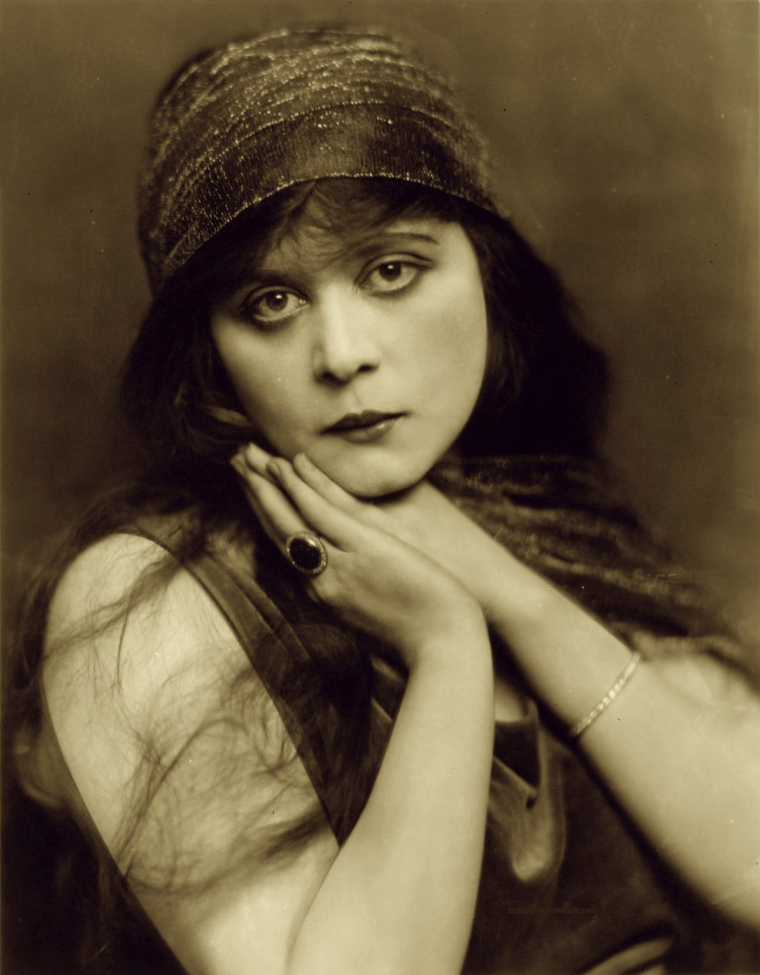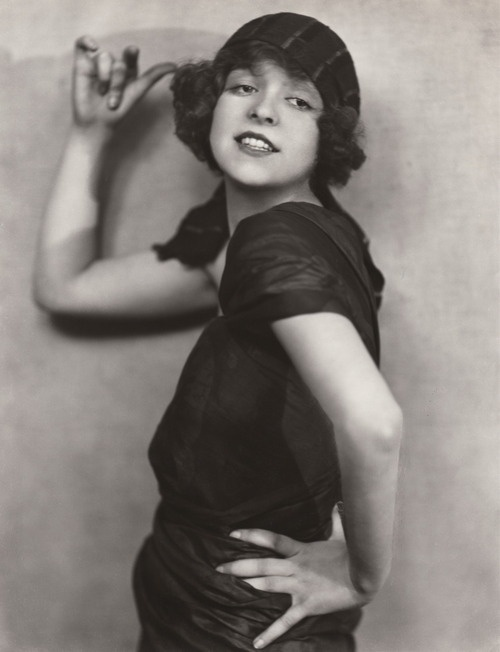Today is the anniversary of the birthdays of not one but two major movie stars from the very early days of the US film industry. Theda Bara was born July 29, 1885, and Clara Bow was born on the same day twenty years later.
Theda Bara was born Theodocia Burr Goodman, in Cincinnati in the US. She only occasionally visited other countries, and those trips were for vacations. But the Fox movie studio publicized her as a mysterious Egyptian-American woman who dabbled in the occult. She never had to fake an accent to support the story, because she only ever performed in silent films. The studio said she was the daughter of a French actress and an Italian sculptor (who they never named, since it wasn’t true), had been born in Egypt, and grew up in up “in the Saraha desert under the shadow of the Sphinx.” In real life, she never even visited Egypt.
Bara began her acting career on Broadway, New York, when she acted in The Devil in 1908. In those days the movie industry was mostly located on the east coast of the US, in and near New York, and Bara became a “contract player” for one of the studios, Fox. She quickly became their biggest star, and by 1917 moved to California where Fox was filming the epic silent movie Cleopatra. Like most of Bara’s films, Cleopatra was destroyed in a fire in the Fox archives in 1937, and no prints have been found since.
Bara was typecast by the studio and nearly always played the same kind of character: a mysterious, sultry woman who might or might not be seducing men magically. She made over 40 films with the studio, and was nationally famous as “The Vamp,” a slang term in that era for seductive women. She took acting seriously, though, and got so tired of being typecast that in 1920 when her contract with Fox expired, she didn’t renew it. This was even though as one of the biggest stars in the country, she could have bargained for significantly more money. Or she might have just gotten tired of acting as a career; after she left Fox she only made two more movies, and although she returned to Broadway plays she didn’t continue that either.
In 1921 she got married to film director Charles Brabin and retired from acting altogether. They built a summer home on the ocean in Nova Scotia, Canada, and a main residence in Cincinnati. She’s commemorated by a star on the Hollywood Walk of Fame, and in 1994 appeared on a US postage stamp. In Fort Lee, New Jersey (where Fox Studios and her film career both began), a street is named Theda Bara Way.
Clara Bow was born in 1905 in Brooklyn, New York. Probably. There’s some controversy about exactly when she was born, and her gravestone says it was 1907. But US Census records show her birth year as 05. Her family was poor, and by the time she was 20 they had lived at 14 different addresses, all in the same area. Her mother suffered from mental illness, and was institutionalized in the early 1920s.
As a girl, Bow was athletic and expected to have a career as an athletics teacher. She won five track and field medals, which she attributed to her trainer, a national champion and world record holder in several foot racing distances — and also her cousin. But when movies became available, she changed her mind and by 16 said she “knew” she wanted to be a motion picture actress. At the same time, though, believed she was a “square, awkward, funny-faced kid.” She entered a nationwide acting contest, “Fame and Fortune,” in 1921 because previous winners had been hired by movie studios. She won the contest, and although the contest sponsor promised to help her “gain a role in films,” she wasn’t offered any roles. She had dropped out of school in expectation of her movie career, though, and got a job in an office instead. She kept visiting movie studio agencies, though, and was finally offered a part in Down to the Sea in Ships, directed by Elmer Clifton. She was the tenth listed actress in the credits, but turned out to be the one noticed by critics. One wrote “In movie parlance, she ‘stole’ the picture.” Bow was still just 16 at the time, and was offered a series of roles as a “tomboy,” and other child-actress roles.
In 1923 Bow moved with her father to Hollywood and got a contract at Preferred Pictures. Movies still lacked sound, but she nevertheless had “speaking lines,” which critics liked. Like Theda Bara, Bow was initially typecast — in Bow’s case, as a “flapper” from the 1920s. But also like Theda Bara, Bow resented typecasting, and tore up her contract in protest. Unlike Theda Bara, though, Bow continued in acting and was before long playing the lead in movies — sometimes produced by studios other than Preferred Pictures. In Hollywood in those days, actors under contract to one studio would be “loaned out” to other studios.
Bow became the “It Girl” once Variety magazine wrote “You can’t get away from this Clara Bow girl. She certainly has that certain ‘It…’” By the late 1920s she was one of the biggest stars in the country. Then in 1929 “talkies” arrived and although she said “I hate talkies. They’re stiff and limiting,” she was still an audience favorite — Brooklyn accent and all.
Bow retired from acting in 1933. She opened The ‘It’ Cafe in the Hollywood Plaza Hotel in 1937, and ran it until 1943, when, like her mother, she was diagnosed with mental illness. She was briefly institutionalized, and after leaving the facility lived alone in a Hollywood bungalow and hardly ever left it for the rest of her life. She died of a heart attack in 1965. Exactly like Theda Bara, Clara Bow has a star on the Hollywood Walk of Fame, and appeared on a US postage stamp.
As far as anybody knows, Clara Bow and Theda Bara never met.

Theda Bara in 1921

Clara Bow in 1921 (photo from the contest she won)
